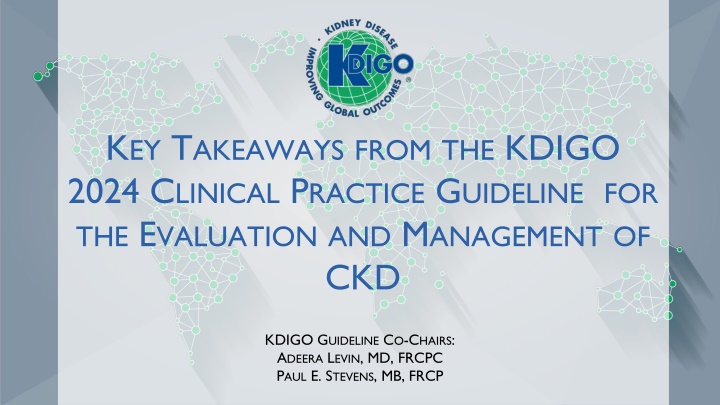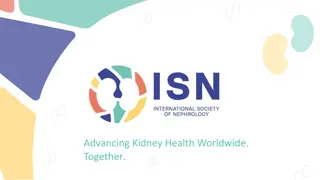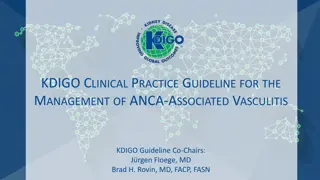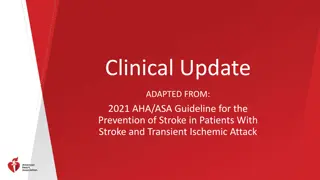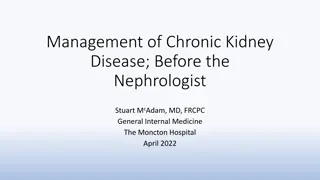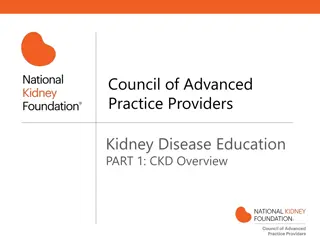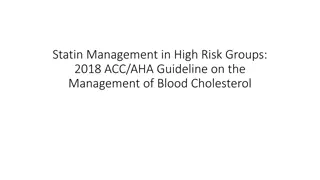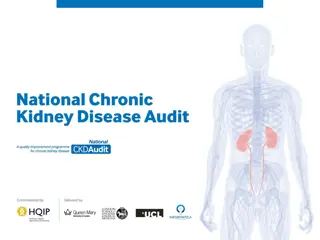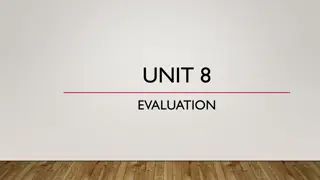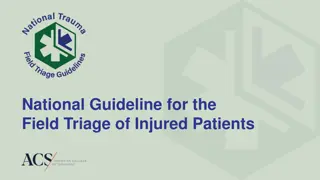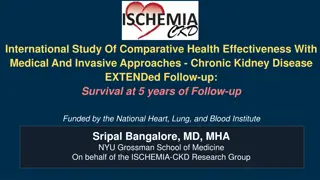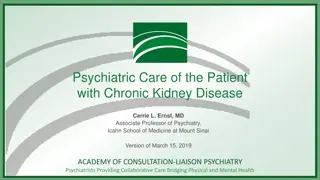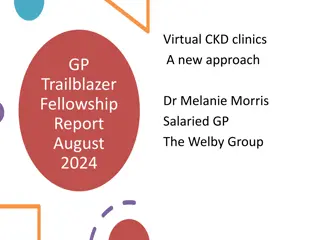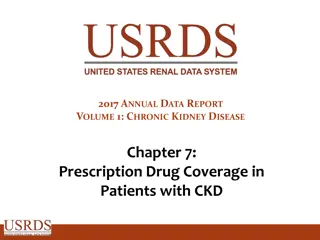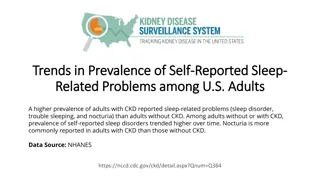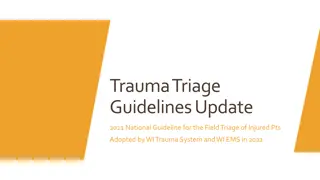Key Takeaways from KDIGO 2024 Clinical Practice Guideline for CKD Evaluation and Management
The KDIGO 2024 guideline emphasizes the importance of evaluating and managing Chronic Kidney Disease (CKD) effectively. It highlights defining CKD, distinguishing between AKD and CKD, personalized care across the lifespan, diagnosing CKD in older adults, and improving the accuracy of GFR assessment. The guideline underscores the need for a comprehensive approach considering various factors to guide interventions and improve outcomes in CKD patients.
Download Presentation

Please find below an Image/Link to download the presentation.
The content on the website is provided AS IS for your information and personal use only. It may not be sold, licensed, or shared on other websites without obtaining consent from the author.If you encounter any issues during the download, it is possible that the publisher has removed the file from their server.
You are allowed to download the files provided on this website for personal or commercial use, subject to the condition that they are used lawfully. All files are the property of their respective owners.
The content on the website is provided AS IS for your information and personal use only. It may not be sold, licensed, or shared on other websites without obtaining consent from the author.
E N D
Presentation Transcript
KEY TAKEAWAYS FROM THE KDIGO 2024 CLINICAL PRACTICE GUIDELINE FOR THE EVALUATION AND MANAGEMENT OF CKD KDIGO GUIDELINE CO-CHAIRS: ADEERA LEVIN, MD, FRCPC PAUL E. STEVENS, MB, FRCP
TOP 10 TAKEAWAYS ON EVALUATION OF PEOPLE WITH OR AT RISK OF CKD
EVALUATION CKD DEFINITION CKD is defined as abnormalities of kidney structure or function, present for >3 months, with implications for health. The definition includes many different markers of kidney damage, not just decreased GFR and ACR and the cause of CKD should be actively sought (Figure). CKD is classified according to Cause, GFR, and ACR to establish severity and guide the type and timing of interventions.
EVALUATION DISTINGUISH BETWEEN AKD AND CKD It is important to distinguish between AKD and CKD and to establish chronicity.
EVALUATION CKD CARE ACROSS THE LIFE SPAN CKD impacts people across the lifespan and as a chronic condition, care is influenced by changes in life circumstances. Use a personalized approach to diagnosis, risk assessment, and management that considers age, sex, and gender. At the extremes of age - the very young and the very old - diagnostic procedures, treatment aims, treatment modalities, and decision-making differ due to differences in prognosis, treatment options, and prioritization.
EVALUATION DIAGNOSIS OF CKD IN OLDER ADULTS Epidemiological population data support retaining the threshold GFR of 60 ml/min/1.73 m2 for diagnosis of CKD in older adults, even in the absence of significant albuminuria, with consistently elevated and increasing relative risk of adverse outcomes below this threshold.
EVALUATION IMPROVING ACCURACY OF GFR ASSESSMENT Estimating GFR from a combination of creatinine and cystatin C (eGFRcr-cys) improves accuracy and strengthens risk relationships. GFR should be measured where more accurate ascertainment of GFR will impact treatment decisions.
EVALUATION ACCURACY AND RELIABILITY Understand the variability of GFR and urinary albumin and the value and limitations of the methodology of assessment when determining whether a change is a true change. Implement the requisite laboratory standards of care to ensure accuracy and reliability.
EVALUATION USE A VALIDATED GFR ESTIMATING EQUATION Use a validated GFR estimating equation to derive GFR from serum filtration markers (eGFR) and use the same equation within geographical regions recognizing that these equations may differ for adults and children.
EVALUATION POINT-OF-CARE TESTS Point-of-care tests (POCT) for creatinine (blood and saliva) and urine albumin measurement are available, and if adequately quality-assured, are accurate enough to facilitate the clinical pathway where access to a laboratory is limited.
EVALUATION USE VALIDATED RISK ASSESSMENT TOOLS Use validated risk assessment tools to aid in decision-making and timing of multidisciplinary care. Choose the appropriate tool for the event of interest: kidney failure treatment, cardiac events, or mortality.
EVALUATION TIMING ASSESSMENT AND REEVALUATION Timing of follow up and reassessment using validated risk prediction tools and clinical evaluation, together with education, may inform better selection of targets of care to support people and families living with CKD. This approach is part of longitudinal care.
TOP 10 TAKEAWAYS ON MANAGEMENT OF PEOPLE WITH OR AT RISK OF CKD
MANAGEMENT COMPREHENSIVE TREATMENT STRATEGY Treat people with CKD with a comprehensive treatment strategy to reduce risks of progression of CKD and its associated complications encompassing education, lifestyle, exercise, smoking cessation, diet, and medications, where indicated.
MANAGEMENT HEALTHY AND DIVERSE DIET Adopting a healthy and diverse diet with a higher consumption of plant-based foods compared to animal-based foods and a lower consumption of ultra-processed foods has the potential to benefit complications related to progressive CKD such as acidosis, hyperkalemia, and hyperphosphatemia with less risk of protein energy-wasting.
MANAGEMENT INDIVIDUALIZE BP CONTROL Individualize BP-lowering therapy and treatment targets in people with frailty, high risk of falls, very limited life expectancy, or symptomatic postural hypotension.
MANAGEMENT RASI AND SGLT2I Treatments that delay progression of CKD with a strong evidence base include RASi and SGLT2i. In people with CKD and heart failure, SGLT2i confer benefits irrespective of albuminuria.
MANAGEMENT ACUTE CHANGES IN EGFR Initial dips in eGFR are expected following initiation of hemodynamically active therapies, including both RASI and SGLT2i. GFR reductions of 30% from baseline exceed the expected variability and warrant evaluation.
MANAGEMENT CARDIOVASCULAR DISEASE AND IMAGING Estimate 10-year cardiovascular risk using a validated risk tool that incorporates CKD to guide treatment for prevention of cardiovascular disease. CKD is not a contraindication to an invasive strategy for people with acute or unstable heart disease. Imaging studies are not necessarily contraindicated in people with CKD and the risks and benefits should be determined on an individual basis. Strategies to mitigate risks from imaging studies using contrast media are easily implemented.
MANAGEMENT PERFORM THOROUGH MEDICATION REVIEW Perform thorough medication review periodically and at transitions of care to assess adherence, continued indication, and potential drug interactions because people with CKD often have complex medication regimens and are seen by multiple specialists. Review and limit the use of over-the-counter medicines, dietary, or herbal remedies that may be harmful for people with CKD. For most people and clinical settings, validated eGFR equations using SCr are appropriate for drug-dosing. Remember, a validated measured GFR is most accurate.
MANAGEMENT DISCONTINUATION AND RESTART OF MEDICATIONS If medications are discontinued during an acute illness, communicate a clear plan of when to restart the discontinued medications to the affected person and healthcare providers, and ensure documentation in the medical record. Failure to restart these medications may lead to unintentional harm.
MANAGEMENT SYMPTOM CONTROL IN CKD The identification and assessment of symptoms in people with progressive CKD is important for highlighting changes in clinical management, redirecting treatment toward patient-centered management, and may lead to discussion about appropriate supportive care options. Effective communication and shared decision-making should be key principles between healthcare providers and the people they treat, allowing them to work in partnership to identify symptom burden, possible treatment strategies and person-centered solutions.
MANAGEMENT ADVANCED CARE PLANNING Plans addressing future health care states should be jointly agreed with people with CKD and their families/carers and known to all. Advanced care planning for those choosing supportive care is particularly important.
